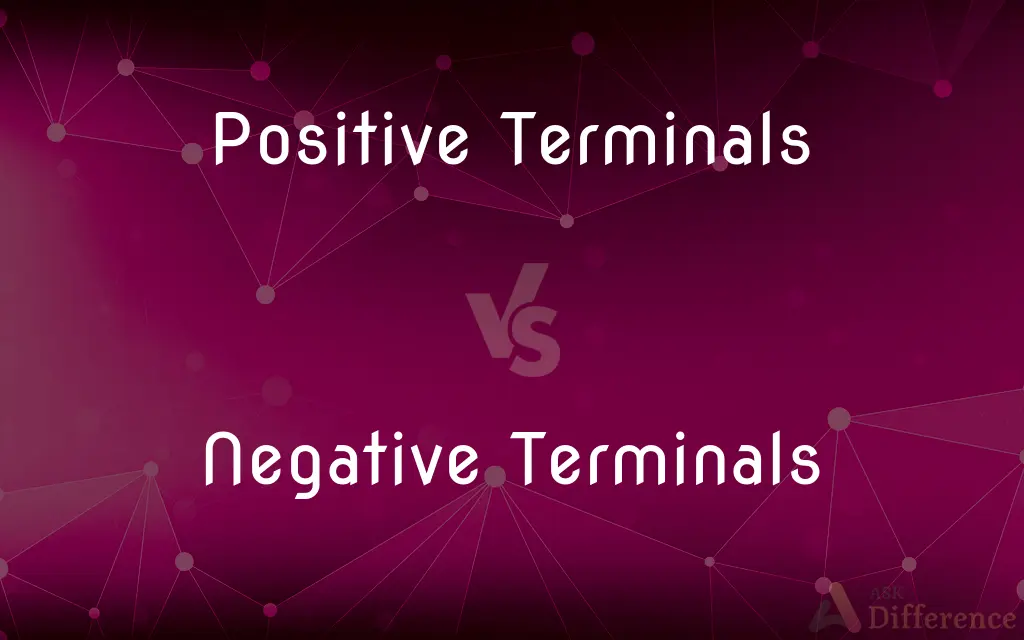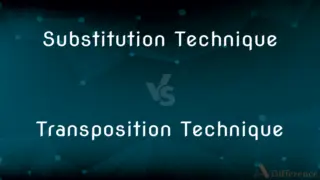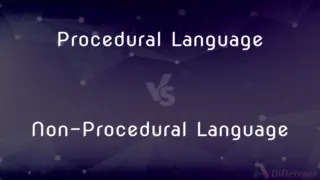Positive Terminals vs. Negative Terminals — What's the Difference?
By Tayyaba Rehman — Published on January 8, 2024
Positive Terminals are terminals in a device where electric current flows into. Negative Terminals are terminals where electric current exits or returns from a device.

Difference Between Positive Terminals and Negative Terminals
Table of Contents
ADVERTISEMENT
Key Differences
Positive terminals are the points in an electrical device or circuit where electric current flows into the device. They are typically connected to the power source, such as a battery or power supply, and are designated as the entry point for current. In many cases, positive terminals are marked with a plus sign (+) for easy identification.
In contrast, negative terminals are the points in a device or circuit where electric current exits or returns from the device. They are connected to the opposite end of the power source compared to the positive terminals. Negative terminals are often marked with a minus sign (-). Current flows from the positive terminal through the device or circuit and exits through the negative terminal.
The difference between positive and negative terminals is crucial in electrical systems. It defines the direction of current flow, which is typically from positive to negative. This flow of electric charge powers electronic devices and allows them to perform their intended functions.
Understanding the roles of positive and negative terminals is fundamental in electronics, as it enables engineers and technicians to design and troubleshoot circuits effectively. Proper connection of components to the correct terminals ensures that devices function as intended and avoids potential damage due to reverse polarity.
Comparison Chart
Role
Entry point for current
Exit or return point for current
ADVERTISEMENT
Marking
Often marked with a plus sign (+)
Often marked with a minus sign (-)
Direction
Current flows into the device
Current exits or returns from the device
Function
Powers the device or circuit
Completes the circuit, allowing current to flow
Compare with Definitions
Positive Terminals
Positive terminals are connected to the power source.
Attach the charger to the device's positive terminal.
Negative Terminals
They function as the exit point for current in circuits.
Ensure a secure connection to the negative terminal.
Positive Terminals
They serve as the entry point for current in circuits.
Connect the red wire to the positive terminal.
Negative Terminals
Negative terminals complete the circuit, allowing current to flow.
Disconnecting the negative terminal stops the current.
Positive Terminals
Current flows from positive to negative terminals.
In this circuit, current starts at the positive terminal.
Negative Terminals
Negative terminals are where electric current exits or returns from a device.
Connect the black wire to the negative terminal of the motor.
Positive Terminals
Positive terminals are where electric current flows into an electrical device.
The battery's positive terminal powers the flashlight.
Negative Terminals
Often marked with a minus sign (-) for easy identification.
Look for the - symbol near the negative terminal.
Positive Terminals
Often marked with a plus sign (+) for identification.
Look for the + symbol near the positive terminal.
Negative Terminals
Current flows from positive to negative, completing the circuit loop.
The negative terminal connects the circuit back to the power source.
Common Curiosities
What are negative terminals in electronics?
Negative terminals are points where electric current exits or returns from a device or circuit.
What is the role of positive terminals in electrical circuits?
They serve as the entry point for current and are often connected to the power source.
How are positive terminals typically marked for identification?
Positive terminals are often marked with a plus sign (+) near the terminal.
What is the function of negative terminals in electrical circuits?
Negative terminals complete the circuit, allowing current to flow, and are often marked with a minus sign (-).
What are positive terminals in electronics?
Positive terminals are points where electric current flows into an electrical device or circuit.
Why is understanding the difference between positive and negative terminals important in electronics?
It ensures proper circuit connection, prevents reverse polarity, and allows devices to function correctly.
What happens if positive and negative terminals are reversed in a circuit?
Reversing terminals can result in incorrect device operation or damage due to reversed current flow.
Can devices have multiple positive and negative terminals?
Yes, complex devices may have multiple terminals for various functions.
Are there situations where current flows from negative to positive terminals?
In certain electronic components, such as diodes, current can flow in the reverse direction.
How can I identify positive and negative terminals in electronic components?
Look for markings, such as plus (+) and minus (-) signs, near the terminals.
Is it essential to connect positive and negative terminals correctly?
Yes, proper connection is crucial to ensure the device functions as intended and to avoid electrical issues.
How does current flow between positive and negative terminals?
Current flows from positive to negative terminals, powering the device or circuit.
How can I troubleshoot electrical problems related to terminals?
Check the correct connection of wires and ensure that positive and negative terminals are correctly aligned.
What should I consider when connecting wires to positive and negative terminals?
Ensure secure connections and follow the device's wiring diagram or instructions.
Can reversing positive and negative terminals damage electronic devices?
Yes, it can lead to incorrect operation or damage due to reverse polarity.
Share Your Discovery

Previous Comparison
Substitution Technique vs. Transposition Technique
Next Comparison
Procedural Language vs. Non-Procedural LanguageAuthor Spotlight
Written by
Tayyaba RehmanTayyaba Rehman is a distinguished writer, currently serving as a primary contributor to askdifference.com. As a researcher in semantics and etymology, Tayyaba's passion for the complexity of languages and their distinctions has found a perfect home on the platform. Tayyaba delves into the intricacies of language, distinguishing between commonly confused words and phrases, thereby providing clarity for readers worldwide.














































